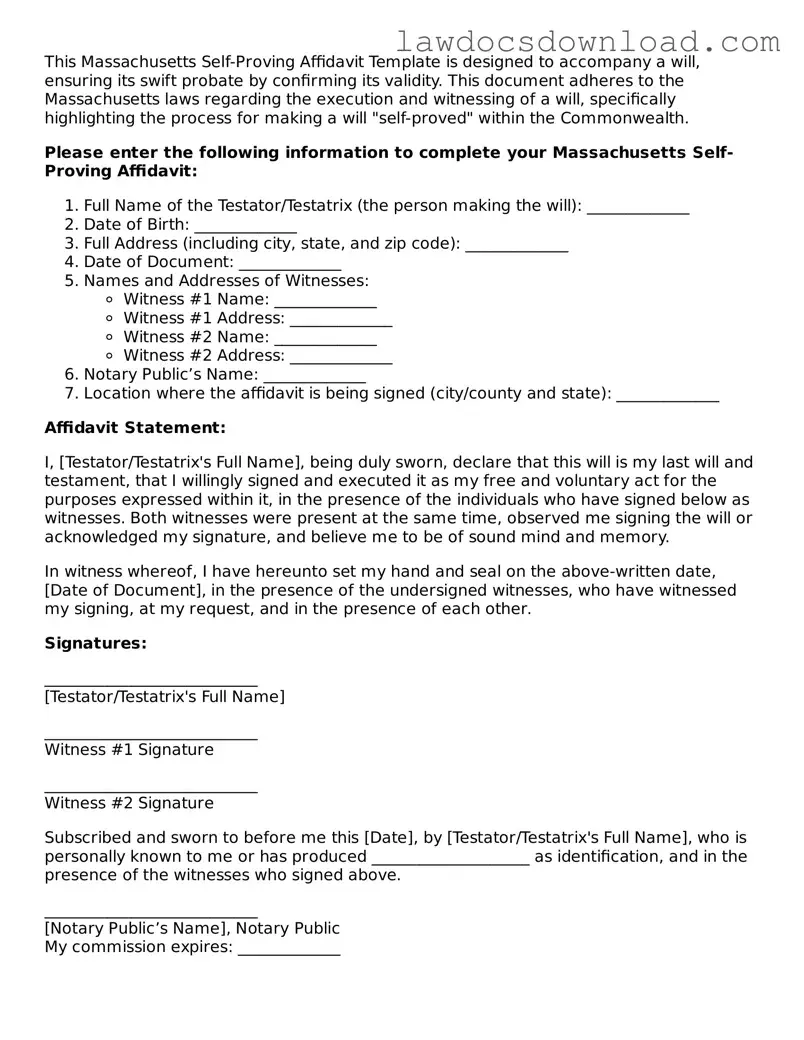The Massachusetts Self-Proving Affidavit form shares similarities with the Last Will and Testament in terms of its purpose in estate planning. Just like a self-proving affidavit certifies the authenticity of the signer's signature, thus streamlining the probate process, a Last Will and Testament outlines an individual’s wishes regarding the distribution of their estate after their death. Both documents serve to clarify intentions and facilitate legal processes, ensuring that an individual's final wishes are honored efficiently and accurately.
Similar to the self-proving affidavit, the Durable Power of Attorney (POA) document is utilized to manage essential affairs, although through a different mechanism. A POA grants another individual the authority to make decisions on one’s behalf, often covering financial or health-related decisions. While the self-proving affidavit streamlines the validation of a document (like a will), a POA enables decision-making processes during a person’s lifetime, particularly in instances where they cannot make decisions themselves.
Likewise, the Advanced Healthcare Directive or Living Will bears resemblance in its anticipatory nature. It specifies an individual's preferences for medical care if they become unable to communicate their decisions. While the self-proving affidavit ensures the credibility of a document’s signatures, living wills safeguard a person’s medical and end-of-life wishes, highlighting both documents' roles in preemptive personal planning.
The Trust Document also displays parallels with the self-proving affidavit by contributing to the management and distribution of one’s assets. Trusts allow for a more controlled and possibly tax-efficient way to handle estate distribution, while the self-proving affidavit aids in verifying the authenticity of a significant estate-planning document, thus expediting its execution. Both are integral in ensuring that assets are allocated according to the person’s desires with minimal legal obstruction.
The Codicil to a Will operates in conjunction with documents like the self-proving affidavit by modifying a previously established will, rather than replacing it entirely. Codicils, like self-proving affidavits, must be witnessed to validate the amendment, ensuring that the changes are legally recognized and executed in accordance with the testator's current wishes.
Similarly, the Declaration of Homestead protects one’s home from being used to satisfy most debts, much like the self-proving affidavit protects the integrity of a will’s signatures. While the homestead exemption is designed to secure an individual’s residence from certain types of creditors, a self-proving affidavit secures the probate process by verifying the authenticity of a will, making both documents protective in nature.
The Bank Safe Deposit Box Inventory form, used to account for the contents of a safe deposit box, shares the self-proving affidavit's emphasis on documentation and verification. This form ensures that the contents are properly recorded, which can be crucial during estate planning and execution, similar to how a self-proving affidavit verifies a will’s signatures to streamline its probate.
The Financial Information Release form, necessary when individuals permit the sharing of their financial data with authorized parties, also echoes the self-proving affidavit’s principle of authorization and verification. While the affidavit confirms the authenticity of document signatures to facilitate legal processes, the release form authorizes entities to access personal financial information, both requiring clear consent for legal actions.
A Grant Deed, used to transfer property ownership, mirrors the self-proving affidavit by necessitating a formal, documented process to validate the transaction. The deed requires official recording and sometimes notarization, analogous to how a self-proving affidavit must be witnessed and notarized to confirm the validity of a will’s signatures. Both ensure that the documents involved in significant transfers, whether of assets or property, are legally binding.
Finally, the Marriage Certificate, as an official record of the union between two individuals, shares commonalities with the self-proving affidavit through its function as a legal document that requires verification. Just as a marriage certificate legitimates a marriage in the eyes of the law, a self-proving affidavit lends credibility to a will, solidifying its standing and expediting its legal acknowledgment.
